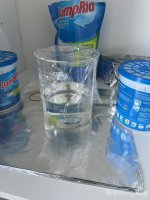- Joined
- Dec 4, 2021
- Messages
- 415
- Solutions
- 1
- Reaction score
- 395
- Points
- 63
Sorry for spamming, but I found the key. The image you post is from the wikipedia article on stereochemistry. It's faulty. That article is pretty heavily critizised in the Talk-section.
The picture I post is the correct one.
The prefixes l and d are just short for dextrorotary or levorotary: which way the molecule rotates polarized light. "l" = levo = to the left, "d" = dextro = to the right. But these prefixes are old and not used anymore.
In the modern nomenclature these have been replaced by the (+) for dextro and the (-) for levo.
The prefixes L and D (uppercase letters) refer to the Fischer projections of the molecules and have nothing to do with how they rotate light, but in what direction key parts of the molecule is drawn. They are in this case actually REVERSED in relation to the d and l prefixes: d is L and l is D.
So L-(+)-tartaric acid means: "a tartaric acid molecule that's drawn with the highest priority group at the top on the Fischer projection and the relevant group pointed to the Left, and rotates polarized light to the right", a.k.a dextrorotary, a.k.a dextro, a.k.a d-tartaric acid. This is the natural form of tartaric acid.
And, of course, vice versa for D-(-)-tartaric acid.
Now, as far as I understand, both isomers of tartaric acid can be used to resolve enantiomers of amphetamines. If you use D-(-)-tartaric acid you will get crystals of d-amph/D-tartrate crashing out, and if you use L-(+)-tartaric acid you will get crystals of l-amph/L-tartrate crashing out.
Using DL-tartaric acid would be absolutely useless, since it wouldn't separate anything: both enantiomers would crash out.
Phew.
I have spoken.
The picture I post is the correct one.
The prefixes l and d are just short for dextrorotary or levorotary: which way the molecule rotates polarized light. "l" = levo = to the left, "d" = dextro = to the right. But these prefixes are old and not used anymore.
In the modern nomenclature these have been replaced by the (+) for dextro and the (-) for levo.
The prefixes L and D (uppercase letters) refer to the Fischer projections of the molecules and have nothing to do with how they rotate light, but in what direction key parts of the molecule is drawn. They are in this case actually REVERSED in relation to the d and l prefixes: d is L and l is D.
So L-(+)-tartaric acid means: "a tartaric acid molecule that's drawn with the highest priority group at the top on the Fischer projection and the relevant group pointed to the Left, and rotates polarized light to the right", a.k.a dextrorotary, a.k.a dextro, a.k.a d-tartaric acid. This is the natural form of tartaric acid.
And, of course, vice versa for D-(-)-tartaric acid.
Now, as far as I understand, both isomers of tartaric acid can be used to resolve enantiomers of amphetamines. If you use D-(-)-tartaric acid you will get crystals of d-amph/D-tartrate crashing out, and if you use L-(+)-tartaric acid you will get crystals of l-amph/L-tartrate crashing out.
Using DL-tartaric acid would be absolutely useless, since it wouldn't separate anything: both enantiomers would crash out.
Phew.
I have spoken.
- Joined
- Dec 26, 2022
- Messages
- 52
- Reaction score
- 31
- Points
- 18
your clarification here across three comments here has been the most clarifying and absolutely useful thing ive fucken read in a while. thank you. I know you posted this like 8 months ago so im just saying it now in case no one else does, this is what i needed to clear the air about all this shit... for years i didnt get it and was too confused to try and come close to making sense of it.... thank you... seriously

